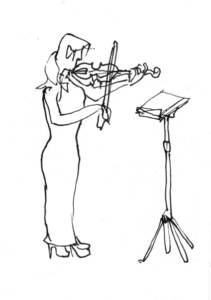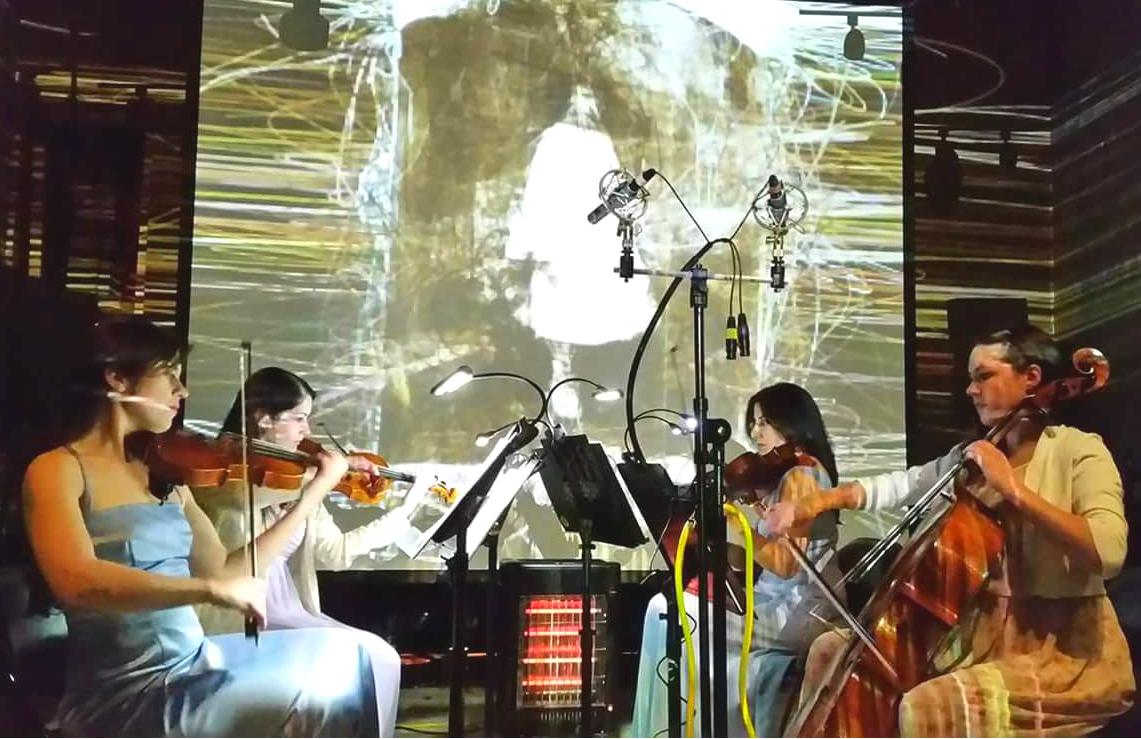When their cellist had to cancel, the string quartet Cantos Y Cuentos made a clever substitution at a recent performance as part of the SoundNow music festival. Nimbleness is not an attribute normally associated with classical music ensembles, but the musicians in this Atlanta chamber ensemble exemplify a spirit of DIY that is emblematic of the city’s players.
The string quartet exists in large part to fill a place its founder Tracy Woodard feels is necessary to the life of the arts community in Atlanta. Specifically, she formed it to perform live scores for silent movies at Eyedrum. More generally, Cantos y Cuentos is the “house band” for modern music at the venerable venue.
SoundNOW is a festival of new music in its third year in Atlanta. The quartet played the M. Rich Center for Creative Arts, one of many locations Eyedrum uses as it searches for a permanent space of its own.
Live contemporary classical music & video art
Although written for string quartet and percussion, the lack of a cellist didn’t stop composer Stephen Wood from conducting the premiere of his “The Plains of Murie.” Jeff Brooks filled the cellist role on bass clarinet, and it worked marvelously, maybe even better than a fourth string instrument although its dynamics sometimes overshadowed in quiet passages. The deep reedy sound gave more sonic range to a piece compositionally successful in evoking open space. The saxophone seemed to be a clever bridge between the two violins (Woodard and Tramaine Jones) and viola (Martha Oceguera), and Paul Steven’s percussion (bass drum, cymbal, temple blocks).
Logic of Natural Order
“The Plains of Murie” was written from the composer’s experience of Denali in Alaska. It is a highly lyric, even romantic piece, while also avoiding excessive narrative or programmatic effects. Initially one hears mixed rhythms and a spare, surprising interplay of elements. Resonant of nature, and how in nature one hears and sees much more than one can hear or see, and yet this very vastness of quality is also contained under the logic of natural order. Later, just as the piece finds a propulsive drive and integration, it ends in a mysterious, modest resolve.
Felt like walking in the woods, coming upon a seeming clear trail (one’s mind imagines it has a grasp of something) and then… it ends in a thicket (surprise, it doesn’t).
Next up, “Consummatum Est” by Máté Balogh was played by the modified quartet. It’s a rather drony piece of long, held notes, and was conducted by Wood — or rather, directed, since Wood referred to a score and pointed to individual players as the piece proceeded, bringing different instruments into and out of focus. A piece whose value depends on a very subtle layering of tones, the players had to work hard to achieve a unified sound from such spare elements.
Here is a version of this played by larger string group in 2014.

Tracy Woodard, drawn rapidly by Jon Ciliberto
Woodard next performed several pieces on her own, although “4 Morpheus Fragments” (2013) by Péter Tornyai had her playing along to pre-recorded tape. Three of the fragments had violin on playback, and the last, a synthesizer. Why would the composer choose to have a second part pre-recorded, rather than scored for a second live performer? Certainly the interaction between a live performer and a recording is vastly different from that between two live performers. Perhaps it was a textural decision or a nod to technology in the recording arts. It was hard to tell.A
Artist Clayton Davis projected individual videos for each piece. They seemed to be responsive, actively or compositionally (or both), but minimally invasive.
“Commendo Spiritum Meum” (2011) by Alan Theisen was “composed for a Good Friday church service” and includes the instruction “Molto lento e meditativo. Con dolore. Come improvvisando.” This means, roughly, “Very slow and meditative. With sadness. Like an improvisation.” The title phrase, of course, is Christ’s final words on the cross. The intense spiritual resignation of all of this was transmuted by virtuosic playing, into a much more searching piece, whose stop and start motif and fierce emotion was remarkably removed from the calm certainty of its title.
Woodard also performed two pieces by the widely-performed Russian-born composer Lera Auerbach on solo violin: “T’filah” (1996) and “Lonely Suite” (2002). Something of a polymath, Auerbach is also a poet (“named Poet of the Year in 1996 by the International Pushkin Society in New York”) and visual artist.
All three string players returned to the stage for the concluding “Three Dances for String Quartet” (2009) by Sunny Knable, with keyboard accompaniment by Paul Stevens.
The players are active in local symphonies, chamber groups, and into the jazz and rock worlds. Woodard is Principal Second Violin for Macon Symphony; violinist Emily Laminack and violist Martha Oceguera perform actively in the region and nationally. Percussionist Paul Stephens is extremely active, playing music across a wide range of genres (he performed solo recently in the High Museum’s Friday Night Jazz series).
On Saturday, May 19th, Woodard is producing a unique performance/workshop at the Atlanta Contemporary Ensemble Composer Workshop. Here, a six-piece ensemble incorporating players from many of Atlanta’s best modern groups performs new music by Michael Kurth (Atlanta Symphony), Susan Clearman, and Anthony Green for contemporary dance, with members of the Suhka Artists contemporary dance company.
Spend some time listening to modern music in Atlanta. You’ll get struck by the enthusiasm of our musicians who bring their considerable talent to bear on the newest music, all presented in an unpretentious, Southern manner.


Add Comment